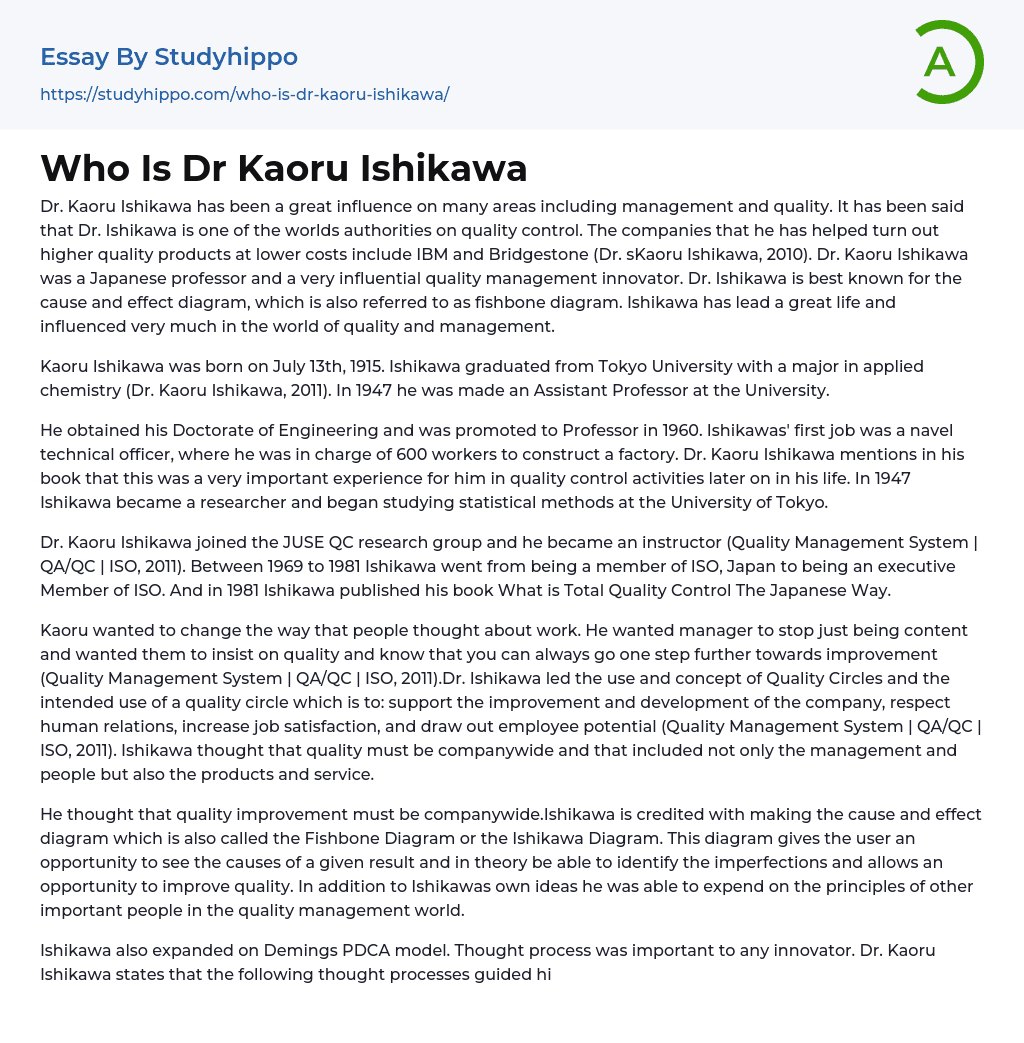The text "
Dr.
" remains unchanged.
Kaoru Ishikawa, a renowned figure in management and quality, has had a profound impact on various fields. He is widely acknowledged as one of the leading global experts on quality control. Notably, he has assisted major companies such as IBM and Bridgestone in enhancing their product quality while reducing costs (Dr. Kaoru Ishikawa, 2010).
Kaoru Ishikawa, a Japanese professor and influential quality management innovator, is best known for developing the fishbone diagram, also known as the cause and effect diagram. He has made significant contributions to the field of quality and management throughout his life. Born on July 13th, 1915, Ishikawa obtained a major in applied chemistry from Tokyo University.
Kaoru Ishikawa (2011) became an Assistant Professor at the University in 1947 and later achieved his Doctorate of Engineering and promotion
...to Professor in 1960. His initial role was as a naval technical officer responsible for overseeing 600 workers in the construction of a factory.
Kaoru Ishikawa highlights the significance of a particular experience in his quality control endeavors. In 1947, he embarked on his research journey at the University of Tokyo, concentrating on statistical methods. Later, Dr. Kaoru Ishikawa joined the JUSE QC research group and assumed the role of an instructor (Quality Management System | QA/QC | ISO, 2011). From 1969 to 1981, Ishikawa transitioned from being a member of ISO Japan to occupying a leadership position as an executive Member of ISO.
In 1981, Ishikawa published his book "What is Total Quality Control The Japanese Way", aiming to change the way people perceive work. He wanted to motivate managers to strive for quality and continuously improve. According to the Quality Management
System | QA/QC | ISO (2011), Ishikawa introduced the concept of Quality Circles, emphasizing their role in supporting company improvement, fostering human relations, increasing job satisfaction, and unleashing employee potential. Ishikawa believed that achieving quality required involvement from all aspects of the company, including management, individuals, products, and services.
He believed that a company should prioritize quality improvement across all departments. Ishikawa is recognized for creating the cause and effect diagram, also known as the Fishbone Diagram or the Ishikawa Diagram. This diagram allows users to visually analyze the causes of a specific outcome and potentially identify areas for quality improvement. Additionally, Ishikawa built upon the ideas of other prominent figures in the quality management field and further developed Deming's PDCA model.
According to Dr. Kaoru Ishikawa, thought process is crucial for any innovator. He emphasizes that engineers who rely on their experimental data must have a thorough understanding of statistical methods (The Quality Management Resource, nd).
Japan relies on imported raw materials and food due to its limited natural resources, making it crucial to enhance exports. Nevertheless, the era of exporting low-quality and inexpensive goods is over. Japan must now concentrate on producing high-quality products that are still affordable. Accomplishing this objective requires a complete dedication to quality control and statistical quality control.
3. During my eight years in the non-academic world after graduating, I realized that Japanese industry and society displayed highly irrational behavior. It was then that I began to believe that studying quality control and implementing it effectively could rectify this irrational behavior. In essence, I believed that applying quality control could revitalize the industry and revolutionize management. Dr. Kaoru Ishikawa played a significant
role in the realm of quality improvement, and his contributions were seen as invaluable. Following his passing in 1989, Juran delivered a heartfelt tribute to acknowledge Ishikawa's profound insights and wisdom.
Dr. Ishikawa was honored with several awards throughout his life. These include the Eugene L. Grant Award from the American Society of Quality, the Blue Ribbon Medal from the Japanese Government for his contributions in industrial standardization, the Walter A. Shewhart Medal, and the Order of the Scared Treasures, Second Class, bestowed by the Japanese Government.
Dr. Ishikawa was continuously striving to advance quality improvement. His impact on the TQM of businesses will endure for years to come.
Sources
- http://www.process-improvement-japan.com/kaoru-Ishikawa.html
- Auction essays
- Balanced Scorecard essays
- Business Plans essays
- Expense essays
- Income essays
- Net Income essays
- Security Guard essays
- Singapore Airlines essays
- Battle essays
- Intranet essays
- Maintenance essays
- Simulation essays
- Inn essays
- Chief Executive Officer essays
- Convenience Store essays
- Firm essays
- Training And Development essays
- Unilever essays
- Variable Cost essays
- Virgin Group essays
- Bargaining essays
- Entity essays
- Pest analysis essays
- Animals essays
- Charles Darwin essays
- Agriculture essays
- Archaeology essays
- Moon essays
- Space Exploration essays
- Sun essays
- Universe essays
- Birds essays
- Horse essays
- Bear essays
- Butterfly essays
- Cat essays
- Dolphin essays
- Monkey essays
- Tiger essays
- Whale essays
- Lion essays
- Elephant essays
- Mythology essays
- Time Travel essays
- Discovery essays
- Thomas Edison essays
- Linguistics essays
- Journal essays
- Chemistry essays
- Biology essays




